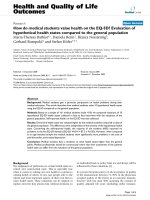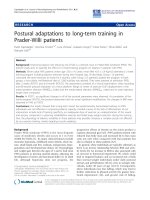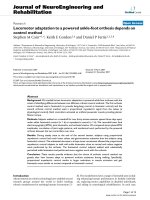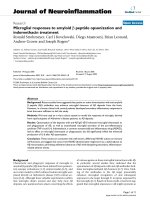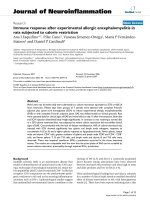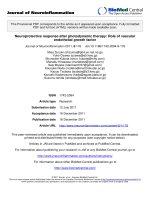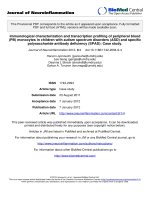báo cáo hóa học:" Immunological response to highly active antiretroviral therapy following treatment for prevention of mother to child transmission of HIV-1: a study in Côte d’Ivoire" pdf
Bạn đang xem bản rút gọn của tài liệu. Xem và tải ngay bản đầy đủ của tài liệu tại đây (382.18 KB, 5 trang )
SHOR T REPOR T Open Access
Immunological response to highly active
antiretroviral therapy following treatment for
prevention of mother to child transmission of
HIV-1: a study in Côte d’Ivoire
Didier K Ekouevi
1,2,3*
, Patrick A Coffie
1,2,3
, Marie-Laure Chaix
4
, Besigin Tonwe-Gold
1,2,5
, Clarisse Amani-Bosse
3,5
,
Valériane Leroy
1,2
, Elaine J Abrams
6
, François Dabis
1,2
Abstract
Background: Information is currently limited on the long-term follow up of HIV-1 infected women who are on
highly active antiretroviral therapy (HAART) that contains nevirapine and lamivudine and who were previously
exposed to antiretroviral drugs for the prevention of mother to child transmission (PMTCT) of HIV.
Methods: We studied the 36-month immunological response to HAART in HIV-1 infected women in Côte d’Ivoire.
The women were previously exposed to antiretroviral drug regimens for PMTCT, including single-dose nevirapine
and/or short-course zidovudine with or without lamivudine. All HAART regimens included a non-nucleoside reverse
transcriptase inhibitor.
Results: At 36 months: the median absolute increase in CD4+ T cell count was +359 cells/mm
3
(IQR: 210- 466) in
200 women who had undergone 36-month follow-up visits; +359 cells/mm
3
(IQR: 222-491) in 88 women not
exposed to PMTCT antiretrovirals; and +363 cells/mm
3
(IQR: 200-464) in 112 women exposed to at least one
antiretroviral PMTCT regimen. Overall, 49 (19.8%) of the 247 women who initiated HAART met the immunological
failure criteria at least once during follow up. The overall probability of immunological failure was 0.08 (95% CI:
0.12-0.15) at 12 months, and 0.21 (95% CI: 0.16-0.27) at 36 months. No difference was observed according to the
presence or absence of resistance mutations to nevirapine or lamivudine in women tested at four weeks
postpartum. In addition, at 36 months, 23% of women were lost to follow up, dead or had stopped their
treatment.
Conclusions: A non-nucleoside reverse transcriptase inhibitor-based antiretroviral regimen, initiated a year or more
after PMTCT exposure and that includes nevirapine, remains a goo d option for at least the first 36 months of
treatment.
Background
Information is currently limited on the long-term fol-
low-up of HIV-1 infected women who are on highly
active antiretroviral therapy (HAART) containing nevir-
apine (NVP) and lamivudine (3TC) and who were pre-
viously exposed to antiretroviral (ARV) drugs for the
prevention of mother to child transmission (PMTCT) of
HIV [1-4].
A 12-month st udy showed a good immunological
response in women previously exposed to ARV drugs
for PMTCT [2]. However, in this study we found a
higher risk of virological failure in women who had
3TC-acquired resistance mutation four weeks postpar-
tum [2]. We now report the immunological response to
HAART at 36 months in women previously exposed to
short-course ARV prophylaxis and study factors asso-
ciated with immunological failure or with immunologi-
cal failure and death according to the history of
PMTCT exposure.
* Correspondence:
1
Centre de recherche, Inserm U 897, Bordeaux France
Full list of author information is available at the end of the article
Ekouevi et al. Journal of the International AIDS Society 2010, 13:28
/>© 2010 Ekouevi et al; licensee BioMed Central Ltd. This is an Open Access article distributed under the terms of the Creative Commons
Attribution License ( which permits unrestricted use, distribution, and reproductio n in
any medium, provided the origina l work is properly cited.
Methods
A prospective cohort study was co nducted in Abidjan,
Côte d’ Ivoire, between August 2003 and June 2009
among all HIV-infected women who initiated HAART
in the MTCT-Plus initiative. The study population and
study design have previously been described [2].
Very briefly, our population consisted of: (1) women
never exposed to any treatment for PMTCT; (2) wome n
exposed to single-dose NVP (sdNVP) and zidovudine
(ZDV) for PMTCT; and (3) women exposed to short-
course zidovudine (scZDV) and 3TC for PMTCT. The
primary variable of interest was the presence of viral
resistance mutation to NVP or 3 TC measured at Week
4 postpartum.
Two outcomes were consider ed after 36 months on
HAART: (1) immunol ogical failure, defined as a 50% fall
from absolute CD4+ T cell count peak level [5]; and (2)
a combined criteria, defined as either immunological
failureortheoccurrenceofdeathduringthefirst36
months of follow up. The virological analyses were done
retrospectively, and results were not available for clinical
use. Decisions to switch antiretroviral regimens were
thus made by local clinicians based on routinely col-
lected immunological and clinical data.
Other study variables measured at time of HAART
initiation were included in the analysis: age, WHO clini-
cal stage, body mass index, hemoglobinemia at HAART
initiation, and self-reported adherence (seven-day self-
report at six, 12, 18, 24, 30 and 36 m onths) [5]. Cox
regression was used to identify factors associated in uni-
variable analysis (p < 0.20) with immunological failure
or t he combined criteria. We censored the follow up of
each patient at the date of last visit, or death, or date of
switch to a protease inhibitor (PI) to evaluate the
response to non-nucleosi de reverse transcriptase inhibi-
tor (NNRTI)-based treatment.
Results
From August 2003 to September 2005, 247 women
initiated 3TC-containing HAART with either NVP or
efavirenz ( EFV). At HAART initiation, their median age
was 28 years (interquarti le range: 25-32) and their med-
ian CD4+ count was 188 cells/mm
3
(IQR: 126-264).
Overall, 28 women (11.3%) were classified at WHO clin-
ical Stage 1; 110 (44.5%) at S tage 2; 96 (38.9%) at Stage
3; and 13 (5.3%) at Stage 4. A total of 109 women
(44.1%) had never been exposed to a PMTCT ARV regi-
men during a previous pregnancy, and 138 (55.9%) had
previously received a PMTCT regimen: 50 had received
scZDV + sdNVP and two sdNVP only; 81 had received
scZDV+sc3TC+sdNVP and five scZDV+3TC only.
Among 73 of the 86 3TC-exposed women tested for
resistance mutations at Week 4 postpartum, 11 (15.1%)
had detectable 3TC resistance mutations. Among 111 of
the 133 sdNVP-exposed women tested at Week 4 post-
partum, 19 (17.1%) had detectable NVP resistance
mutations.
The first-line HAART regimen was ZDV+3TC+NVP
in 234 (95.1%) women, and stavudine (d4T)+3TC+NVP
in seven (2.9%) women; five women started HAART
with ZDV+3TC+EFV and one began with d4T+3TC
+EFV. The median time between exposure to sdNVP
and initiation of H AART was 21 months (IQR: 13-26).
During the 36 months of follow up, 30 women (12.1%)
were lost to follow up, 10 (4.0%) stopped treatment at
their own request, and 17 (6.9%) d ied. Furthermore , 19
out of 247 (7.7%) HIV-infected women switched to PI-
based HAART. The reasons for switching were immu-
nological failure in four patients and side effects related
to NVP o r EFV in 15 cases. There was no association
between switching to PI and PMTCT-acquired resis-
tance to NVP (p = 0.43) or to 3TC (p = 0.93).
At 36 months, the median absolute increase in CD4+
count was +359 cells/mm
3
(IQR: 210-466) in 200
women who had undergone 36-month follow-up visits.
Theincreasewas+359cells/mm
3
(IQR: 222-491) in 88
womennotexposedtoPMTCTARV,and+363cells/
mm
3
(IQR: 200-464) in 112 women exposed to at least
one ARV PMTCT regimen. The median absolute
increase in CD4 count was +366 cells/mm
3
(IQR: 174-
461) in the 18 w omen with NVP resistance at Week 4
postpartum, and > 230 ce lls/mm3 (IQR: 130-403) in the
eigh t women with 3TC resistance mutati ons detected at
Week 4 postpartum (Figures 1A and 1B). When analyses
of immunological response were restricted to the 184
women who did not switch to a PI during the follow up,
the median absolute increase in C D4+ count was 361
cells/mm
3
(IQR: 220-466) at 36 months.
Overall, 49 (19.8%), (95% CI 15.0-25.3%) of the 247
women who ini tiated HAART met the immunological
failure criteria at least once during follow up. Regarding
immunologic failure, no statistical difference was found
between the women unexposed to sdNVP, those
exposed to NVP without resistance mutations, and
those with NVP resistance mutations at Week 4 post-
partum (14.7% vs. 19.8% vs. 25.0%, respectively, p =
0.50). The same conclusion was draw n for 3TC expo-
sure (14.7% in women unexposed to 3TC vs. 14.8% in
women exposed without 3TC-resistance mutation vs.
18.2% in women exposed with 3TC-resistance muta-
tions, p = 0.71).
The overall probability of immunological failure was
0.08 (95% CI: 0.12-0.15) at 12 months, 0.14 (95% CI:
0.10-0.19) at 24 months and 0.21 (95% CI: 0.16-0.27) at
36 months. At 36 months, the probability of immunolo-
gical failure wa s 0.25 (95% CI: 0.18-0.28) in women who
Ekouevi et al. Journal of the International AIDS Society 2010, 13:28
/>Page 2 of 5
selected a 3TC-resistant v irus after PMTCT and 0.21
(95% CI: 0.14-0.31) in women who selected a NVP-
resistant virus.
For the second outcome (death or immunological fail-
ure), the probability at 36 months was 0.26 (95% CI:
0.20-0.31) in the overall population. It was 0.32 (95% CI:
0.16-0.58) in women who had NVP resistance mutations
at Week 4, and 0.30 (95% CI: 0.11- 0.68) in women with
3TC resistance mutation at Week 4.
In multivariate analysis (n = 247), the only factor asso-
ciated with immunological failure was poor self-reported
adherence (adjusted Hazard Ratio, aHR, 2.61; 95% CI
1.43-4.74, p = 0. 002), controlling for resistance muta-
tions and exposure to NVP or 3TC, CD4 count,
Figure 1 Immunological response in HIV-infected women. A. Immunological response in HIV-infected women exposed to nevirapine or
acquired PMTCT resistance to nevirapine. B. Immunological response in HIV-infected women exposed to lamivudine or acquired PMTCT
resistance to lamivudine. NVP = nevirapine. 3TC = lamivudine. N = number of patients with CD4 count available at baseline (M0). n = number of
patients with CD4 count available at month 36 (M36).
Ekouevi et al. Journal of the International AIDS Society 2010, 13:28
/>Page 3 of 5
maternal age, WHO clinical stage, and hemoglobinemia
at HAART initiation. Self-reported adherence was also
associated with the combined criteria (aHR 4.14; 95% CI
2.39-7.19, p < 0.001).
Discussion
During the 36 months of follow up, we did not find any
diff erences for immunological failure related to the pre-
sence or absence of NVP- or 3TC-resistance mutations
at Week 4 postpartum. Our findings are consistent with
those reported by others for shorter periods of follow
up [1-4,6], and suppo rt the recommendation to us e
NNRTI-based regimens in women previously exposed to
NVP when the delay between the exposure to NVP and
HAARTinitiationislongerthan12months[6].The
long delay between PMTCT exposure and HAART
initiation in our study likely resulted in the fading of
detectable resistance mutations acquired with PMTCT
ARV exposure [7,8].
We also reported that 7.7% of the women switched
from NNRTI-based to PI-based HAART during follow
up. Among the 19 women who switched to PI-based
HAART, only four switches were related to treatment
failure; the other 15 were done to manage NNRTI-
related drug toxicity. While 49 (19.8%) women met
immuno logic criteria for failure at least once during fol-
low up, very few were changed to second-line therapy.
Similar findings have been reported in the Médecins
Sans Frontières multi-country cohort, with an incidence
of switch of 4.8 per 1000 person -years [9]. Reasons that
patients did not switch were not recorded, but we
hypothesize that this is a common practice in settings
with limited availability of ARV drugs, and where physi-
cians often choose to reinforce adherence and postpone
regimen changes in clinically stable patients.
Two limitations are noted. First, there is a lack of viral
load data, which is not routinely monitored and
recorded in our study area. Such data is important to
fully understand the dynamics and rate of treatment fail-
ure in our population. Switching treatments without
using viral load data for making these decisions is
indeed of utmost concern [10,11]. Second, the limited
sample size implies limited statistical power to detect
any immunologic difference between the groups of
interest variable studied. However, our results were con-
sistent with previous reports [3,4,6].
In addition, 23% of women were lost to follow up,
dead or had stopped treatment at 36 months, and were
no longer on treatment despite the establishment of a
well-funded programme with excellent resources [12].
However, very fe w data are available on long-te rm fol-
low up of ART treatment in l ow income-countries to
make any comparison between studies. In sub-Saharan
Africa, 38% of patients were lost to care and therefore
no longer on treatment after two years of follow up [13].
Conclusions
In conclusion, an NNRTI-based antiretroviral regimen,
which includes NVP, initiated at least one year after
PMTCT exp osure remains a good option for at least the
first 36 months of treatment. Larger studies, preferably
with virological and genotypic test data, are needed to
confirm our findings and to better decide when to
switch HAART regimens.
Acknowledgements
This study was presented at the 15
th
International Conference on AIDS and
STIs in Africa (ICASA), Dakar, Senegal, 3-7 December 2009 [abstract 1842].
The MTCT-Plus care and treatment programme in Abidjan is supported by
the MTCT-Plus Initiative through the International Center for AIDS Care and
Treatment Programs at the Columbia University Mailman School of Public
Health, New York, NY, USA. The MTCT-Plus Initiative is funded by several
private US foundations .
The ANRS 1201/1202 Ditrame Plus trial cohort, on which the MTCT-Plus
Abidjan programme was built, was funded by the Agence Nationale de
Recherches sur le Sida et les Hépatites Virales (ANRS, Paris, France), with
additional support from the French Charity Sidaction (Paris, France).
Didier Ekouevi was a fellow of the French Charity Sidaction (2002-2004), and
then of the European and Developing Countries Clinical Trials Partnership.
Patrick Coffie is now a fellow of the French Charity Sidaction. This project
received additional unrestricted financial support from GlaxoSmithKline.
Author details
1
Centre de recherche, Inserm U 897, Bordeaux France.
2
Institut de Santé
Publique, Epidémiologie et Développement, Université Victor Segalen
Bordeaux 2, Bordeaux, France.
3
ANRS DITRAME PLUS Project, Programme
PAC-CI, Abidjan, Côte d’Ivoire.
4
Université René Descartes, EA 3620,
Assistance Publique - Hôpitaux de Paris, Laboratoire de Virologie, Hôpital
Necker Enfants Malades, Paris, France.
5
MTCT-Plus initiative, ACONDA,
Abidjan, Côte d’Ivoire.
6
MTCT-Plus Initiative, International Center for AIDS
Care and Treatment Programs, Mailman School of Public Health, Columbia
University, New York, NY, USA.
Authors’ contributions
DKE, PAC and FD designed the study. PAC and CAB collected the data. DKE
and PC analyzed the data. DKE and PAC interpreted the data. All authors
contributed to the writin g of the manuscript, and all authors approved the
manuscript for publication.
Competing interests
The authors declare that they have no competing interests.
Received: 17 December 2009 Accepted: 2 August 2010
Published: 2 August 2010
References
1. Chi BH, Sinkala M, Stringer EM, Cantrell RA, Mtonga V, Bulterys M, Zulu I,
Kankasa C, Wilfert C, Weidle PJ, Vermund SH, Stringer JS: Early clinical and
immune response to NNRTI-based antiretroviral therapy among women
with prior exposure to single-dose nevirapine. AIDS 2007, 21(8):957-964.
2. Coffie PA, Ekouevi DK, Chaix ML, Tonwe-Gold B, Clarisse AB, Becquet R,
Viho I, N’dri-Yoman T, Leroy V, Abrams EJ, Rouzioux C, Dabis F: Maternal
12-month response to antiretroviral therapy following prevention of
mother-to-child transmission of HIV type 1, Ivory Coast, 2003-2006. Clin
Infect Dis 2008, 46(4):611-621.
3. Jourdain G, Ngo-Giang-Huong N, Le Coeur S, Bowonwatanuwong C,
Kantipong P, Leechanachai P, Ariyadej S, Leenasirimakul P, Hammer S,
Lallemant M, Perinatal HIV Prevention Trial Group: Intrapartum exposure to
Ekouevi et al. Journal of the International AIDS Society 2010, 13:28
/>Page 4 of 5
nevirapine and subsequent maternal responses to nevirapine-based
antiretroviral therapy. N Engl J Med 2004, 351(3):229-240.
4. Lockman S, Shapiro RL, Smeaton LM, Wester C, Thior I, Stevens L, Chand F,
Makhema J, Moffat C, Asmelash A, Ndase P, Arimi P, van Widenfelt E,
Mazhani L, Novitsky V, Lagakos S, Essex M: Response to antiretroviral
therapy after a single, peripartum dose of nevirapine. N Engl J Med 2007,
356(2):135-147.
5. World Health Organization: Antiretroviral drugs for treating pregnant women
and preventing HIV infection in infants in resource-limited settings: towards
universal access. Recommendations for a public health approach 2006 [http://
www.who.int/hiv/pub/mtct/arv_guidelines_mtct.pdf], (accessed 26 March
2010).
6. Stringer JS, McConnell MS, Kiarie J, Bolu O, Anekthananon T,
Jariyasethpong T, Potter D, Mutsotso W, Borkowf CB, Mbori-Ngacha D,
Muiruri P, Ong’ech JO, Zulu I, Njobvu L, Jetsawang B, Pathak S, Bulterys M,
Shaffer N, Weidle PJ: Effectiveness of non-nucleoside reverse-
transcriptase inhibitor-based antiretroviral therapy in women previously
exposed to a single intrapartum dose of nevirapine: a multi-country,
prospective cohort study. PLoS Med 2010, 7(2):e1000233
7. Chaix ML, Ekouevi DK, Peytavin G, Rouet F, Tonwe-Gold B, Viho I, Bequet L,
Amani-Bosse C, Menan H, Leroy V, Rouzioux C, Dabis F: Impact of
nevirapine (NVP) plasma concentration on selection of resistant virus in
mothers who received single-dose NVP to prevent perinatal human
immunodeficiency virus type 1 transmission and persistence of resistant
virus in their infected children. Antimicrob Agents Chemother 2007,
51(3):896-901.
8. Eshleman SH, Mracna M, Guay LA, Deseyve M, Cunningham S,
Mirochnick M, Musoke P, Fleming T, Glenn Fowler M, Mofenson LM,
Mmiro F, Jackson JB: Selection and fading of resistance mutations in
women and infants receiving nevirapine to prevent HIV-1 vertical
transmission (HIVNET 012). AIDS 2001, 15(15):1951-1957.
9. Pujades-Rodriguez M, O’Brien D, Humblet P, Calmy A: Second-line
antiretroviral therapy in resource-limited settings: the experience of
Medecins Sans Frontieres. AIDS 2008, 22(11):1305-1312.
10. Calmy A, Ford N, Hirschel B, Reynolds SJ, Lynen L, Goemaere E, Garcia de la
Vega F, Perrin L, Rodriguez W: HIV viral load monitoring in resource-
limited regions: optional or necessary? Clin Infect Dis 2007, 44(1):128-134.
11. Reynolds SJ, Nakigozi G, Newell K, Ndyanabo A, Galiwongo R, Boaz I,
Quinn TC, Gray R, Wawer M, Serwadda D: Failure of immunologic criteria
to appropriately identify antiretroviral treatment failure in Uganda. AIDS
2009, 23(6):697-700.
12. Tonwe-Gold B, Ekouevi DK, Bosse CA, Toure S, Kone M, Becquet R, Leroy V,
Toro P, Dabis F, El Sadr WM, Abrams EJ: Implementing family-focused HIV
care and treatment: the first 2 years’ experience of the mother-to-child
transmission-plus program in Abidjan, Cote d’Ivoire. Trop Med Int Health
2009, 14(2):204-212.
13. Rosen S, Fox MP, Gill CJ: Patient retention in antiretroviral therapy
programs in sub-Saharan Africa: a systematic review. PLoS Med 2007,
4(10):e298
doi:10.1186/1758-2652-13-28
Cite this article as: Ekoue vi et al.: Immunological response to highly
active antire troviral therapy following treatment for prevention of
mother to child transmission of HIV-1: a study in Côte d’Ivoire. Journal
of the International AIDS Society 2010 13:28.
Submit your next manuscript to BioMed Central
and take full advantage of:
• Convenient online submission
• Thorough peer review
• No space constraints or color figure charges
• Immediate publication on acceptance
• Inclusion in PubMed, CAS, Scopus and Google Scholar
• Research which is freely available for redistribution
Submit your manuscript at
www.biomedcentral.com/submit
Ekouevi et al. Journal of the International AIDS Society 2010, 13:28
/>Page 5 of 5


